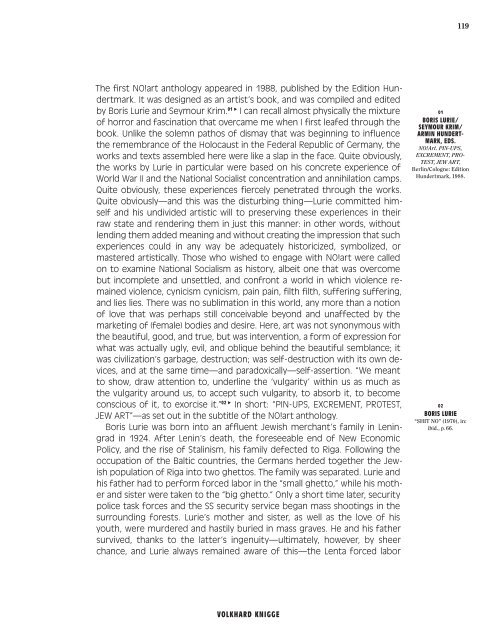The Art of
Katalog_Boris-Lurie_English
Katalog_Boris-Lurie_English
Create successful ePaper yourself
Turn your PDF publications into a flip-book with our unique Google optimized e-Paper software.
119<br />
<strong>The</strong> first NO!art anthology appeared in 1988, published by the Edition Hundertmark.<br />
It was designed as an artist’s book, and was compiled and edited<br />
by Boris Lurie and Seymour Krim. 01 I can recall almost physically the mixture<br />
<strong>of</strong> horror and fascination that overcame me when I first leafed through the<br />
book. Unlike the solemn pathos <strong>of</strong> dismay that was beginning to influence<br />
the remembrance <strong>of</strong> the Holocaust in the Federal Republic <strong>of</strong> Germany, the<br />
works and texts assembled here were like a slap in the face. Quite obviously,<br />
the works by Lurie in particular were based on his concrete experience <strong>of</strong><br />
World War II and the National Socialist concentration and annihilation camps.<br />
Quite obviously, these experiences fiercely penetrated through the works.<br />
Quite obviously—and this was the disturbing thing—Lurie committed himself<br />
and his undivided artistic will to preserving these experiences in their<br />
raw state and rendering them in just this manner: in other words, without<br />
lending them added meaning and without creating the impression that such<br />
experiences could in any way be adequately historicized, symbolized, or<br />
mastered artistically. Those who wished to engage with NO!art were called<br />
on to examine National Socialism as history, albeit one that was overcome<br />
but incomplete and unsettled, and confront a world in which violence remained<br />
violence, cynicism cynicism, pain pain, filth filth, suffering suffering,<br />
and lies lies. <strong>The</strong>re was no sublimation in this world, any more than a notion<br />
<strong>of</strong> love that was perhaps still conceivable beyond and unaffected by the<br />
marketing <strong>of</strong> (female) bodies and desire. Here, art was not synonymous with<br />
the beautiful, good, and true, but was intervention, a form <strong>of</strong> expression for<br />
what was actually ugly, evil, and oblique behind the beautiful semblance; it<br />
was civilization’s garbage, destruction; was self-destruction with its own devices,<br />
and at the same time—and paradoxically—self-assertion. “We meant<br />
to show, draw attention to, underline the ‘vulgarity’ within us as much as<br />
the vulgarity around us, to accept such vulgarity, to absorb it, to become<br />
conscious <strong>of</strong> it, to exorcise it.” 02 In short: “PIN-UPS, EXCREMENT, PROTEST,<br />
JEW ART”—as set out in the subtitle <strong>of</strong> the NO!art anthology.<br />
Boris Lurie was born into an affluent Jewish merchant’s family in Leningrad<br />
in 1924. After Lenin’s death, the foreseeable end <strong>of</strong> New Economic<br />
Policy, and the rise <strong>of</strong> Stalinism, his family defected to Riga. Following the<br />
occupation <strong>of</strong> the Baltic countries, the Germans herded together the Jewish<br />
population <strong>of</strong> Riga into two ghettos. <strong>The</strong> family was separated. Lurie and<br />
his father had to perform forced labor in the “small ghetto,” while his mother<br />
and sister were taken to the “big ghetto.” Only a short time later, security<br />
police task forces and the SS security service began mass shootings in the<br />
surrounding forests. Lurie’s mother and sister, as well as the love <strong>of</strong> his<br />
youth, were murdered and hastily buried in mass graves. He and his father<br />
survived, thanks to the latter’s ingenuity—ultimately, however, by sheer<br />
chance, and Lurie always remained aware <strong>of</strong> this—the Lenta forced labor<br />
01<br />
BORIS LURIE/<br />
SEYMOUR KRIM/<br />
ARMIN HUNDERT-<br />
MARK, EDS.<br />
NO!<strong>Art</strong>. PIN-UPS,<br />
EXCREMENT, PRO-<br />
TEST, JEW ART,<br />
Berlin/Cologne: Edition<br />
Hundertmark, 1988.<br />
02<br />
BORIS LURIE<br />
“SHIT NO” (1970), in:<br />
ibid., p. 66.<br />
VOLKHARD KNIGGE



